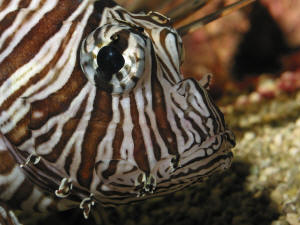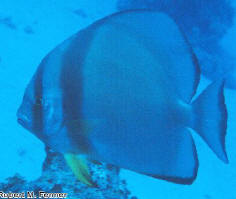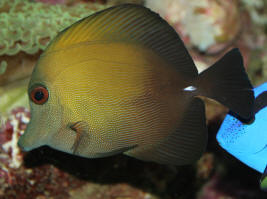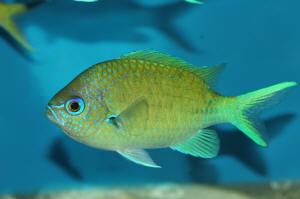
by Anthony Calfo
For
more than a few years now, people have reported seeing various non-indigenous
marine fishes along the Tropical Atlantic coast of the United States of America.
In most cases, they have been isolated specimens in isolated locations. In some
circumstances, private homeowners would occasionally see ornamental specimens
living in their quiet “backwater” canals. Other times, the exotics have been
observed lingering around patch reefs, or in lagoons. The source of some of
these fishes was suspected to be release from hobbyists or a rare escape of
commercially-held specimens from wholesalers of imported fishes during
hurricanes or severe storms. But such small numbers of fishes (usually single
specimens) cannot form founding populations easily, if at all. And so, the
establishment of the Indo-Pacific Pterois Lionfishes in Atlantic waters
has been quite a mystery.
To
compound the mystery even further, some investigators are inclined to believe
that the origin of the founder population of Pterois is on the coast of
North Carolina, and not Florida, as most people would expect. At first glance,
this is perplexing. To begin with, Florida is the only state in America, outside
of Hawai’i, that has a climate even remotely comparable to the Indo-Pacific.
Moreover, Florida has an enormous industry of established trade in marine
ornamental fishes: both import and export. Florida also has one of the largest
state populations and, subsequently, one of the largest bases of participating
saltwater hobbyists. These are more likely sources of introduced exotics.
|
.JPG) |
|
Indo-Pacific lionfishes now appear to be established in the Tropical West
Atlantic. Photo Anthony Calfo |
By
contrast, however, North Carolina has a rather modest population, and a
relatively weak marine hobby market. In fact, they have fewer livestock
retailers and hobbyist clubs than most other states in America. The weather,
although usually mild, can also be very cold in the winter, and snowfall is
recorded. Thus, the statistical likelihood of Pterois
establishing along North Carolina coasts seems unlikely compared to Florida. But
we must consider all potential sources of a founding population of Lionfishes,
beyond the obvious ones stated, before we dismiss or the theory of a North
Carolina origin.
By
most estimates, there is a reproducing population of Pterois lionfishes
in the Western Atlantic. Their population is estimated to be numbering in the
thousands. It is not even restricted to the Tropical waters, either! This may
sound impossible, but it is interestingly true. The ocean currents shift in
summertime with a pattern called the “Gulf Stream” that sends very warm waters
from the Tropical West Atlantic north towards New York. Remarkably, species of
beautiful Florida and Caribbean fishes can be seen and collected during this
time of year along the northern Atlantic coasts.
Joe
Yaiullo, Director of the Atlantic Marine World facility, has been collecting
“Gulf” species off the coast of New York each summer for many years. I’ve known
Joe as a colleague in the aquarium industry for over ten years, and I asked him
recently if he’d ever seen Pterois Lionfishes in any of his collections.
With an amused smile, he told a story of his first experience with Pterois
species in New York waters. He had been asked to do exploratory collections to
see if Lionfishes could be found locally. Upon accepting the challenge, Joe
reported that within the first 30 minutes of his first collection, he netted a
bucket full of juvenile Pterois specimens! He then brought them back to
his facility (pers. comm. 2005) where he put them on display for education and
public awareness. These specimens were collected merely by wading into shallow
water and captured with nets. [note: Atlantis Marine World is a fabulous
facility for tourists, aquatic scientists and marine hobbyists alike, which
includes an 80,000 liter coral reef display that is magnificent! For more
information on the Internet, visit
http://www.atlantismarineworld.com/]
|
 |
|
Pterois is a formidable
predator with patience and persistence. Photo Anthony Calfo |
Sightings of Pterois
Lionfishes to date have been reported along most of the Atlantic coast of the
USA and from Bermuda in the South to New York in the North. One of the first
specimens captured by a fisherman with hook and line was off the coast of North
Carolina; the specimen was approximately 43 cm long and over one kilo in weight.
Presently, removal of this established exotic fish seems impossible. There have
been concerns voiced about public safety, regarding swimmers and divers getting
stung by members of this venomous genus, but most experts agree that these are
very small risks. No fatalities have been recorded from Pterois
envenomation here, and the sightings of specimens at large have mostly been
offshore and in deep water (over 20m). The biggest concern overall is the
potential reduction or elimination of native species by this non-native
predator. While reports of Pterois in the Atlantic have occurred for
perhaps ten years or more, very little study has been done to estimate the
impact of the exotic or it’s potential ramifications. Experts are not only
unsure about what, if anything, to do about the presence of these fishes… but
they cannot even agree on the specific source of the introduced specimens!
While
some scientists and investigators would like to ascribe the establishment of
exotic species to hobbyist release of pet specimens, the practical reality as I
see it makes this a highly unlikely explanation. To begin with, it seems
implausible that enough individual hobbyists would coincidentally decide to
release enough specimens near enough to each other on a reef to found a colony
of exotics. Furthermore, unwanted specimens are often overgrown, unfit from a
captive life, and generally suffering from inadequate food (e.g. - thyroid
problems from iodine deficient foods) and poor exercise in small home aquaria.
They simply lack conditioning to find and compete for food on a wild reef, not
to mention avoiding the perils of would-be predators. And even if they
acclimated to the wild waters sufficiently… the odds of so few specimens finding
each other on a reef, at the right time (s) to spawn, seems small. Then, the
small batches of larvae from a successful spawn would have to survive on alien
plankters in alien currents on an alien reef. Beyond that, enough of these
larvae would need to successfully settle out and then grow to maturity in such
(initially) small population numbers to then find each other some years in the
future to spawn with hope for continuation. The statistical likelihood of a
favorable outcome to individual releases of pet fishes being the origin of these
exotics is slight, to say the least, in my opinion.
|
.JPG) |
|
Caution: Pterois volitans can
quickly outgrow small home aquaria! Photo Anthony Calfo |
Another theory argued is that dive or tourism merchants seeded isolated patch
reefs with imported batches of these fishes to improve revenue for their sites
and attractions. As preposterous, if not nefarious, as the notion sounds, some
significant aspects of the appearance of Lionfishes in the Atlantic do not
exclude this possibility. In fact, there may be great credibility to the
assertion. Investigators have complained that (some, not all) dive operators
have been uncooperative with scientists seeking information on where to find
Lionfishes on remote reefs. One could speculate that the merchants are
protecting their “discovery”, if not their “investment.” As a possible founder
source, it is at least consistent with early appearances of Pterois in
North Carolina and beyond: most observations of the fish to date have been far
offshore on isolated reefs at depth. These sites are miles away from the coastal
waters where a hobbyist would likely spill and release a pet fish. And the
likelihood of such poorly conditioned (captively grown) fishes swimming through
vast stretches of open ocean to reach offshore reefs safely seems rather
unlikely, compared to the chances of adults simply being seeded directly (by
boat operators) on an isolated reef, or settling from larvae released or
dispersed.
 |
 |
|
The release of pet fishes
likely explains the appearance, albeit rare in number, of Indo-Pacific
angels or tangs in Florida waters.
Platax orbicularis
(L) Photo by Robert Fenner Zebrasoma Scopas (R). Photo by Anthony
Calfo. |
This notion of
larvae as the source of introduction is also quite interesting. One might
wonder, initially, where would enough larvae come from to seed a reef to found a
breeding population? How could eggs or larvae from the Indo-Pacific survive the
trek to the Atlantic coast of America? On further consideration, though,
carriage by boat with ballast water seems to be a plausible explanation. In
fact, other fishes and invertebrates have been transported as contaminants this
way. Notably, the egg masses of Lionfishes are sticky, durable and float. By
this nature, they can easily come into concentrated contact with surface sailing
boats. With this theory in mind, we can also see that North Carolina is home to
some of the largest and busiest ports and shipyards in America. This situation
is bolstered tremendously perhaps by the presence of naval ships. The
unfortunate political realities in the Middle East have additionally spurred a
number of military vessels to travel to the Indo-Pacific, Persian Gulf, etc. The
possibility of piscine contaminants with many thousands of gallons of water
being repeatedly transported by boats from afar is possible here, and is yet
another remarkable theory
|
 |
|
The Indo-Pacific Chromis viridis has been spotted in Atlantic waters.
Photo by Anthony Calfo |
For what its
worth, I honestly don’t have a strong opinion on what the principal source of
Pterois was to establish a breeding population. All of the theories
presented to date are equally possible and equally unlikely to me at the same
time. Could hobbyists really be the source of the foundling population? Yes… I
do believe it is possible. Especially if we have underestimated the span of time
that occasional releases from private owners of unwanted fishes has occurred.
Pterois spp. are indeed long-lived and obviously better protected (venomous
spines) than most other fishes. Their establishment is not so surprising,
whereas small numbers of other notable exotic species have been observed only
sporadically through the years, such as Pomacanthid angelfishes, Acanthurid
surgeons and tangs, and various small fishes such as Pomacentrid damsels. There
is even a concern about the increasing appearance of Pacific Ephippid
spadefishes (AKA “batfishes”) schooling with Atlantic species: the worry is that
they will interbreed. Still, it is remarkable to me that enough specimens of any
exotic can survive any of the proposed theories of introduction in the dynamic
Tropical West Atlantic ocean to establish a colony. And whether you tolerate or
dislike the reality of exotic introductions, it is at least testimony to the
hardiness and adaptability of some amazing and beautiful reef fishes.
Resources and Bibliography:
http://www.atlantismarineworld.com/
http://www.hawaiiaquaculture.org/marineornamentals06.html
www.noaa.gov/
http://www.aquaticinvaders.org/nan_browse.cfm?level=4&key=130205000000
http://www.invasivespecies.gov/ismonth/archives/lionfish/lionfish.html
Dr Robert
Goldstein, “Lionfish in the Western Atlantic,” Seascope, Volume 21, Issue 2,
2004
Also:
MARINE ORNAMENTALS
(conference) 2006 February 13-16, 2006 Las Vegas, Nevada for discussions with
academics and industry professionals of aquatic science.
"Characterizing the US Trade in Lionfishes"
10/28/19
Contact: Dr. Kevin Erickson
Fund@MASNA.org (mailto:Fund@MASNA.org)
Dr. Junda Lin Memorial Fund for Publishing Open Access Marine Aquarium Research
website HERE
(https://masna.org/masna-programs/memorial-publishing-fund/?utm_source=Public+BOD+Email&utm_campaign=902484607a-Junda+Fund+q3+2018_COPY_01&utm_medium=email&utm_term=0_684126d033-902484607a-457263653)
For Release on October 28, 2019
MASNA's Q3 2018 Open Access Memorial Fund Article now freely available to the
public.
MASNA is proud to announce that the Quarter 3, 2018 publication funded by the
Dr. Junda Lin Memorial Fund for Publishing Open Access Marine Aquarium Research
is now freely available to the public as an open access article.
https://gallery.mailchimp.com/b544bbbb4469dc4cd62e9b2df/images/a242edea-13cc-4ff7-bb37-08171500969d.jpgIn?utm_source=Public+BOD+Email&utm_campaign=902484607a-Junda+Fund+q3+2018_COPY_01&utm_medium=email&utm_term=0_684126d033-902484607a-457263653
2017, MASNA introduced the Dr. Junda Lin Memorial Fund for Publishing Open
Access Marine Aquarium Research with the goal to off-set the cost to students of
publishing research as open access articles in order to promote the spread of
scientific ideas to not only scientists, but to anyone who is interested in the
research, by making it freely available.
Dr. Junda Lin was a Professor of Biological Sciences at the Florida Institute of
Technology and the Director of the Institute for Marine Research (IMR). Dr.
Lin’s Lab focused on the development of aquaculture technology for marine
ornamental species to offset and replace wild collection. Dr. Lin’s lab studied
the basic biological processes of several shellfish and fish species, evaluated
their aquaculture potential, and developed cultivation technology.
Rather than the traditional scientific publishing scheme where the reader of the
scientific article incurs a cost to access the article, open access articles
charge the author a fee when the article is accepted by the publisher, resulting
in scientific literature that is freely available to the entire world.
Therefore, the Dr. Junda Lin Memorial Fund for Publishing Open Access Marine
Aquarium Research is a fund sponsored by individuals, aquarium clubs,
businesses, and universities that provides students with a financial offset to
the costs of publishing a scientific article as an open access article. More
information on how to apply and the donation link can be found here:
http://masna.org/masna-programs/memorial-publishing-fund/?utm_source=Public+BOD+Email&utm_campaign=902484607a-Junda+Fund+q3+2018_COPY_01&utm_medium=email&utm_term=0_684126d033-902484607a-457263653
Our 2018 Q3 recipient is Tim Lyons, M.Sc,
https://gallery.mailchimp.com/b544bbbb4469dc4cd62e9b2df/_compresseds/52b93210-f5dc-415d-851e-7f02539df2cf.jpgA?utm_source=Public+BOD+Email&utm_campaign=902484607a-Junda+Fund+q3+2018_COPY_01&utm_medium=email&utm_term=0_684126d033-902484607a-457263653
conservation scientist based out of the New Mexico BioPark Society in
Albuquerque, New Mexico.
Tim is the primary author of the paper entitled “Characterizing the US
Trade in Lionfishes (https://journals.plos.org/plosone/article?
id=10.1371/journal.pone.0221272&utm_source=Public+BOD+Email&utm_campaign=902484607a-Junda+Fund+q3+2018_COPY_01&utm_medium=email&utm_term=0_684126d033-902484607a-457263653)
”, which was published by PLoS ONE in August of 2019. In his original research
article, Tim and his coauthors identify the volume and diversity of Lionfishes
exported from source countries, imported into the United States, and ultimately
lionfish availability in retail settings. This information is intended to
provide managers and policymakers with a proactive evaluation of Lionfishes
traded within the country that are closely related to the highly invasive Red
Lionfish in the Gulf of Mexico and the Caribbean. Together with character trait
evaluation and rapid risk screening protocols, these data can reveal potentially
risky species that may present an invasion threat if released into the
environment.
Tim summarizes the importance of this research here:
“Invasive species continue to have significant detrimental effects on local
ecosystems, and they remain one of the most homogenizing forces on global
biodiversity. Eradicating or slowing the spread of introduced species once they
establish can be extremely difficult. Environmental damages and control programs
for invasive marine and freshwater fishes in the U.S. cost managers and
stakeholders an estimated $5.4 billion each year.
The global trade in marine ornamental species supports collector, wholesaler,
and retailer livelihoods, and can produce conservation benefits through public
exposure and outreach. However, the global trade in these species is not without
its drawbacks, including the potential introduction and establishment of
non-native species resulting from intentional or unintentional release. While
the majority of these one-off introductions are benign, others, such as the
introduction of red lionfish into coastal waters off southern Florida, have had
major, long-lasting impacts on native reef communities.
https://gallery.mailchimp.com/b544bbbb4469dc4cd62e9b2df/images/5f225e06-980a-4962-9c96-2a2b7170fb6a.png?utm_source=Public+BOD+Email&utm_campaign=902484607a-Junda+Fund+q3+2018_COPY_01&utm_medium=email&utm_term=0_684126d033-902484607a-457263653
Given the sheer volume and diversity of the marine ornamental trade, evaluating
the risk of every species that may potentially be introduced into a non-native
range is both cost-prohibitive and unfeasible. However, it is possible to
evaluate the risk of species traded that share common characteristics to known
invaders. This information can be used to inform proactive management
approaches, and ultimately reduce or prevent the number of risky species that
get introduced.
https://gallery.mailchimp.com/b544bbbb4469dc4cd62e9b2df/images/bafdeea4-c33f-468b-8ddd-d189deb23be5.png?utm_source=Public+BOD+Email&utm_campaign=902484607a-Junda+Fund+q3+2018_COPY_01&utm_medium=email&utm_term=0_684126d033-902484607a-457263653
We used federally and state collected trade data on Lionfishes to draw the
following conclusions: The marine ornamental trade is a potentially strong
introduction pathway for just two species of Lionfishes, namely the Red Lionfish
Pterois volitans and the Zebra Lionfish Dendrochirus zebra. The trade is a
moderate to very weak pathway for all other species of Lionfishes that can be
found in the trade. Lionfish import is highly concentrated at the port of Los
Angeles, and most specimens originate from the Philippines and Indonesia. Retail
surveys indicated a much more limited diversity of Lionfishes available to
hobbyists than previously thought, especially when compared to stock lists
provided by online vendors.
https://gallery.mailchimp.com/b544bbbb4469dc4cd62e9b2df/images/40da301f-d001-47a3-9ff2-a61376702ed3.png?utm_source=Public+BOD+Email&utm_campaign=902484607a-Junda+Fund+q3+2018_COPY_01&utm_medium=email&utm_term=0_684126d033-902484607a-457263653
These data have several implications. The first is that there is likely
significant lionfish mortality occurring from the time lionfish enter the
country to the time that they are available in retail aquarium stores. Second,
our analysis suggests that broad, blanket regulations on the trade of Lionfishes
at the genus level, such as those imposed by Florida state regulatory agencies,
may be unnecessary. Finally, our data suggests that the riskiest species of
lionfish from a trade volume perspective is still the Red Lionfish. While this
species is already established in Florida waters, the vast number of species in
trade are still imported from the Indo-Pacific. Therefore, secondary
introductions have the potential to introduce new novel genes or traits that
strengthen the impacts of the current lionfish invasion in the Atlantic Ocean.”
_____________
Scientific research has historically been published and distributed by
for-profit companies that require readers to pay to access content, comprising a
19.6 billion dollar industry that results in inaccessibility for most hobbyists.
However, open access publishing has been gaining traction in recent years.
Project S, an initiative that promotes specific open-access publishing
requirements for scientific research funded through public grants, has recently
been endorsed by several international governments. Additionally, research
institutions have begun terminating long-standing subscriptions to for-profit
journals, and many independent researchers have taken an active stance on
information dissemination by opting to publish in open-access formats. MASNA
fully supports open-access publishing, and firmly believes that research
relating to aquarium science should be available to anyone who wishes to read
it. For more details on recent open-access publishing developments, read HERE
(https://www.theguardian.com/education/2019/mar/28/paywalls-block-scientific-progress-research-should-be-open-to-everyone?utm_source=Public+BOD+Email&utm_campaign=902484607a-Junda+Fund+q3+2018_COPY_01&utm_medium=email&utm_term=0_684126d033-902484607a-457263653)
.
MASNA would like to thank the donors that have contributed to the Junda Lin
Memorial Fund thus far. Open-access publications allow the rapid dissemination
of research to the non-scientific public that would otherwise not be able to
access this information.
The modern marine sciences increasingly recognize the importance of informed
hobbyists and citizen scientists in data collection, volunteer work, and in
their ability to drive changes in public outlook and policy. MASNA welcomes
donations from any organization or individual who shares the belief that
advancements in science should be freely available to the general public, and
those that support MASNA’s mission to encourage the sustainability and ethical
growth of the marine aquarium industry through the education of its members and
the wider hobbyist community.
About MASNA:
MASNA is a 501(c)(3) non-profit organization composed of marine aquarium
societies, individual hobbyists, and industry partners from North America and
abroad, totaling several thousand individuals.
MASNA’s goals are to:
* Educate our members through online and published material, the MACNA
conference, and other sanctioned events.
* Assist in forming and promoting the growth of clubs within the hobby while
ensuring a sustainable future for the marine environment.
* Support the efforts to eliminate abuses in collecting and transporting marine
organisms through education, assistance, and encouragement.
* Encourage the ethical growth of the marine aquarium hobby and support captive
breeding/propagation efforts.
More at www.MASNA.org
- # # # -
Click here to read the article
(https://journals.plos.org/plosone/article?id=10.1371/journal.pone.0221272&utm_source=Public+BOD+Email&utm_campaign=902484607a-Junda+Fund+q3+2018_COPY_01&utm_medium=email&utm_term=0_684126d033-902484607a-457263653)
Q from a Scientist - Caribbean
Sharpnose Puffers Nipping Off Fish Spines? 8/22/11
Hi there,
<Hello Merritt here.>
I'm a graduate student doing some work on lionfish down in the
Caribbean and witnessed an unusual interaction between invasive
lionfish and a Caribbean Sharpnose Puffer (Canthigaster
rostrata) that I'd be curious to hear your take on!
<Great! Helping with the lionfish invasion are you.>
During the capture, handling, and tagging of lionfish that makes up the
bulk of my project, the skin covering the venomous dorsal spines of
lionfish are often tugged down as they poke through the collection nets.
On one occasion, after one such fish was released from its bag and was
sitting on the reef recovering, a Sharpnose puffer came over and began
biting at the exposed portion of the dorsal spines. On fish re-sighted
after tagging, these exposed spines are often shorter and blunted, as
though the exposed end has been bitten off. I was just wondering if your
team has had any experiences with Sharpnose puffers biting off fish
spines in the past, and on what might cause this behavior?
<Actually I have personally witnessed puffers of many species exhibiting
this behavior in an aquarium. I can only assume in an aquarium that the
behavior is either one of territory defense or two them being typical
puffers.>
I know they're known for biting in close quarters, but this didn't look
like a territorial encounter as the puffer looked more like he was
grazing or investigating a snack than trying to drive the lionfish off.
I wondered if there's any nutritional benefit to puffers from nipping
fins or spines that might explain this?
<None that I know of.>
I've benefited from the wisdom of WWM many times before, and recognize
that for many of the less-studied marine ornamentals, hobbyists probably
know more about behavior than academics, so I look forward to hearing
what you think. Thanks a million!
<From what I have seen puffers tend to be very curious creatures and
tend to bite things/objects to figure out what they are. Others will
just pick on tank mates (especially lionfish) by nipping their fins
and/or harassing them until the fish is removed or dies. I will assume
this observed behavior to be of curiosity and obnoxiousness that makes
up a puffer personality than for nutritional benefit. Good luck on your
research and hope that you find a solution to the lionfish invasion.
Merritt>
--
Natascia Tamburello
MSc Candidate
Tropical Marine Ecology Lab
Department of Biological Sciences
Simon Fraser University
